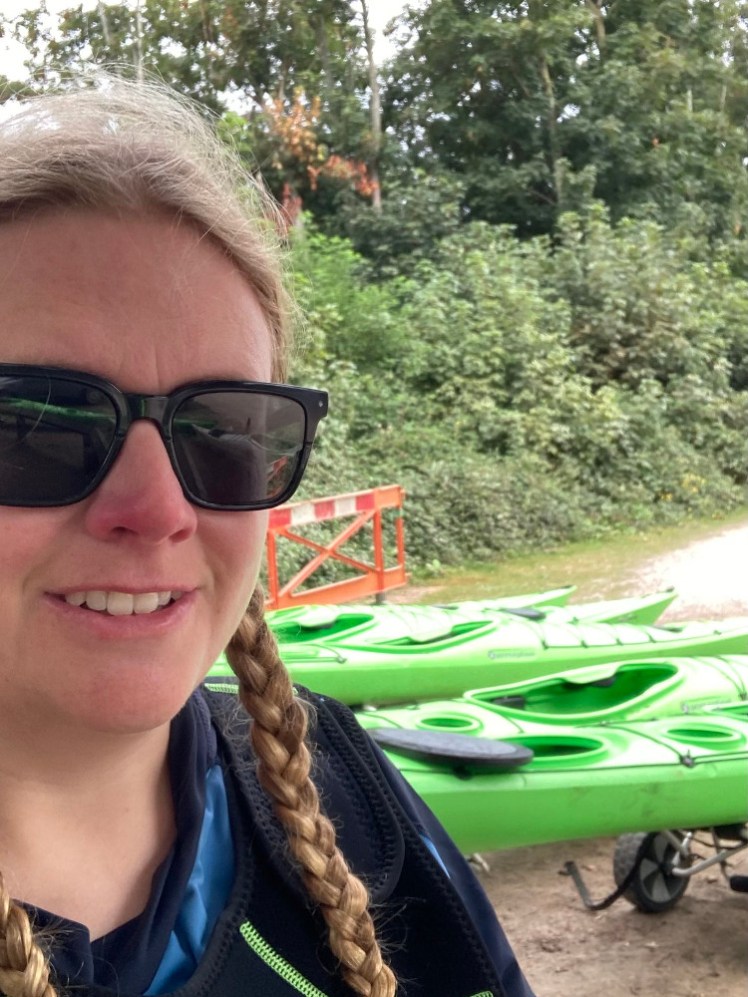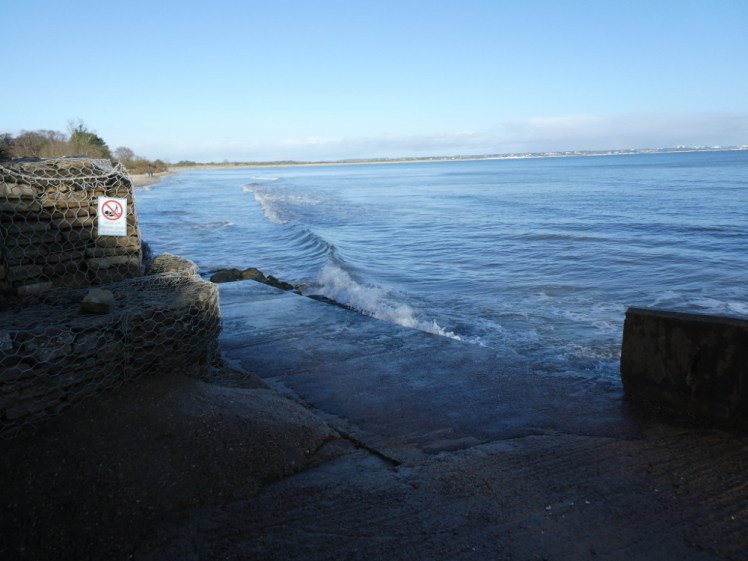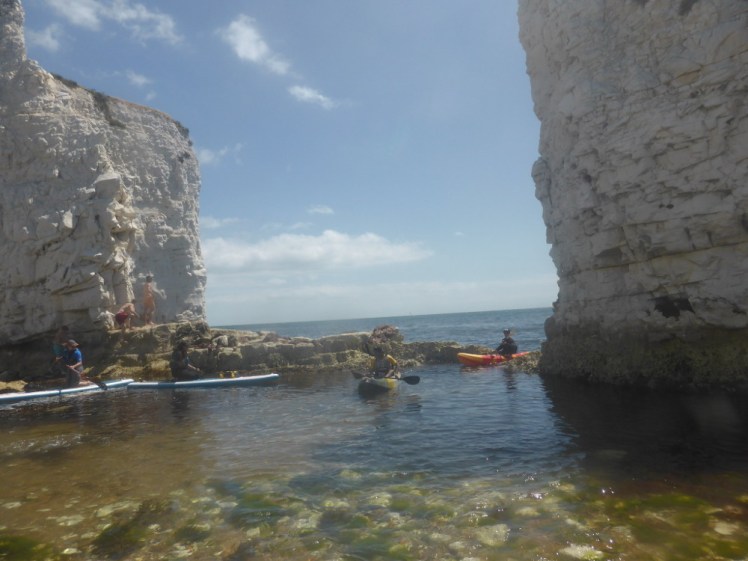I’ve been kayaking before. I’ve been kayaking on the sea before – in fact, I’ve only ever been kayaking on the sea. But this post is about learning to kayak on a closed cockpit sea kayak with a spraydeck. The reason is there’s a thing I wanted to do but it’s only available to groups in double open kayaks. They have single kayaks for groups with odd numbers but they don’t want you to book as an individual, they want you to go on the closed cockpit ones because they’re all single-user crafts.
But the last time I was in a closed kayak with a spraydeck, I was about eleven and in a 16m school swimming pool. I already knew I’m not keen on hanging upside down from a capsized kayak anymore and my Discover course back in July absolutely confirmed that. All the same, the booking conditions of the thing were that we had to be comfortable in closed kayaks and knowing that I’m not, or at least not with the spraydeck, I knew I had to go and practice. So I booked onto the half-day closed kayak course and went into it knowing many months in advance that I was going to have to capsize. I still don’t like it but I’d rather know about it months in advance than five minutes in advance. Anyway, my plan is obviously to not capsize when I do the thing and I’m a more competent and capable kayaker than I was the first time I went out on one, when we capsized about six times and ended up lashed to the rest of the group, so hopefully I can stay upright even if the sea is a bit “fruity”.
In preparation for falling out, I packed my goggles and I bought the nose clip that I couldn’t find for Explore two months ago. I also immediately decided I hated it. I’ve never had my nose so comprehensively sealed before. It feels immensely claustrophobic and I guarantee it’ll make me open my mouth, swallow half the sea and die.

So there I was. 8.45am at Studland, getting into my wetsuit in a dusty car park while the boys who paddle as easily as most people breathe were busy pulling out the kayaks, giving them a wash, finding the kit etc. There were three groups there – a half day trip out to Old Harry Rocks, a two-hour trip out to Old Harry and the six of us who were going to learn how to paddle a sea kayak. Our outfit was a little different. Five of us had our own wetsuits, three our own buoyancy aids (which were checked for the correct safety ratings before we were allowed to use them) and we had spraydecks. The others left with their instructors, down the zigzag path to the beach where their sit-on-top kayaks were waiting at the storage hut. Our sea kayaks were up at the top hut, though, and we had to haul them down the road to the slipway.
Now, on my Explore course I used a closed cockpit kayak, although without a spraydeck. That was a Dagger Axis 10.5. It’s 10ft 6in long and 72cm wide and costs £849. Today I had a real sea kayak. A Perception Essence 17. You guessed it, 17 feet long, it’s 58cm wide and this model, with a skeg, would set me back £1279. Paddling it was one thing. Pulling it out of the car park and easing it between the boulders that stop cars driving down to the slipway was quite another, not to mention the bend in the road. Seventeen feet! This thing is designed to cut straight through waves and to react to any movement of the water but when you sit in it, there’s half a mile of long thin boat in front of you and that’s very disconcerting. Even if I’d been comfortable with the spraydeck, this was a very different boat and one you need to get used to before you do a thing.

First we had to adjust the footrests. I didn’t succeed in this with the Axis but our instructor, Elliott, explained that you can hook them with your foot and that loosens the lever and you can just pull them. Pushing them further back was another matter but luckily mine were too far away and so I could easily pull them closed. Then we had to tackle the spraydecks. Elliott’s was neoprene, so it stretches, but ours were nylon. There are pros and cons to this. From my point of view, a massive pro is that there’s no stretch. If the kayak flips, my weight will pretty much instantly detach the spraydeck from the boat and I’ll fall straight out. Elliott’s stretches, so he would need to yank it free. We did have to learn about the art of keeping the grab handle out and how to find it in an emergency but in this particular case, we’d be unlikely to need to actually do that. First good thing. A con is that it’s a pig to put on. For one thing, there’s so much going on that we were trying to fasten the spraydeck to the back of the seat at first. And then there’s that lack of stretch. You hook it on at the back and then you go to hook it on at the front and the back pops right off. It took two people to do it and once you were in, you couldn’t lean forward without popping it. Which I guess is another good sign that if you fall out, the spraydeck will sort itself out.
“Are you going to make us do it deliberately?” I asked.
No. Elliott had no plans for mandatory escape practice. Those of us who wanted to try it could do so, on the way back so we didn’t get cold for too long but as long as we knew the theory, we didn’t have to do the practical. Ok, now I could relax. Two months I’ve been dreading this but I could relax and enjoy the paddle secure in the knowledge that I could stay in my boat.
We weren’t going to launch from the slipway. We waded into the water and towed the boats across to the beach. We’d settle them on the waterline, get in, get spraydecked (get Elliott to hold onto the back) and then shuffle forward until we were afloat. I was triumphant at doing my own spraydeck all by myself. Then I stuck my hands out to shuffle and… pop. The thing had come off at the back! Elliott fixed it and towed me out to save me risking another pop and then we paddled a few feet out, just enough to not beach ourselves while everyone else got on the water.

Did I mention that the kayak is really long and thin? Did I mention we had some pretty “fruity” waves coming onshore? Oh, the thing wobbles! I’ll say here and now that I did get used to it after a while but the first few minutes involved a lot of squeaking, a lot of gasping and whimpering and a lot of bodily tension. On the one hand, if I capsized I’d just be on the bottom. On the other, there surely wasn’t enough sea room to manoeuvre myself out of the kayak. You can’t fall out when there’s less than eight inches of water between the bottom of the sea and the upside down top of the boat.
We paddled slowly south, all of us getting used to the sensation of rocking with the waves and of being confined to the boat. We’d all kayaked before and I got the impression Raf had done more than us, judging by the beautiful stern rudder he used on the way back. My own stern rudder got some good use, actually. Just off South Beach Elliott stopped us to discuss turning the boats. They’re meant to cut through waves. They’re meant to go forward. Of course, they will turn but they don’t like it. So we practised our forward side sweep on one side and our backward side sweep on the other to pivot. That meant turning side-on to the waves at times, which is something I don’t like. I just hear Locke and Jean in Red Seas Under Red Skies:
“What’s it mean if we broach?” said Jean.
“Ah, gods,” [Locke] said. “I know this. It’s… something… bad”.
“To meet strong winds and seas abeam,” said Jean, “taking them on the side, rather than cutting through them with the bow.”
“And that’s bad.”
“Powerful bad.”
Well, my kayak was broached but the waves were less here and I stayed upright, although scared. It’s not that long ago I’d have capsized in waves like that.
Once we’d all practised turning and Elliott had talked about paddling forward, we turned east and followed the cliffs out to Old Harry. I was here only the week before, albeit on a sit-on-top that I’d hired from Knoll Beach. I’d had the luxury of looking around, spotting birds, getting a good look at the chalk cliffs then. Today, in a long thin boat and bigger waves than I liked, I very quickly found that if my attention wandered even a few feet for even a few seconds, the boat wobbled unpleasantly. No time to enjoy the views, then. Concentrate on the sea.
I’ll say one thing. However scary it was, Studland Bay is pretty shallow. We had to dodge a fisherman three-quarters of the way along those cliffs. A fisherman standing in the water. I’m sure you can imagine how easy it is for the water to knock someone over in conditions like that, so although I can’t remember how deep it was on him, it wasn’t high enough for him to struggle to stand up. Probably not even waist high. That’s why I chose Studland Bay as my playground back in 2019 when I bought an inflatable kayak from Lidl. Sure, it’s the open sea. It’s also very shallow and pretty sheltered and I took the half-day trip out to Old Harry to make sure I was up to date on everything I needed to know before I took to sea on my own.
However, when we were in sight of Old Harry, Elliott was dubious about going through and investigating the other side, like he’d planned. He left us bobbing around while he went to look through the gaps and came back to report that it was “fruity” and that he was a bit torn about it. Good judgement here, because “I’m a bit torn” was immediately followed by “which probably means I shouldn’t do it”. I was already going to volunteer to stay on the calmer side. Old Harry is the end of Studland Bay and beyond it, you really are out on the open sea. That famous day when I capsized six times, it was a millpond in the bay but choppy enough to capsize six times in ten minutes beyond. Today was more than a bit choppy. Prevailing winds around here are from the south-west which makes the corner behind Old Harry pretty sheltered usually but for the last couple of weeks, the wind has been coming from the north and the east and it was even worse beyond.

While we sat there admiring the rocks from the safer side, the half-day group came back. They’re on sit-on-tops so if anyone capsizes, you just turn the boat back over and shove them back on. No faffing around with wet exits, draining the cockpit, back deck scramble or trying to force the spraydeck back on. And indeed, as we watched them come through the gap between the headland and the big stack beyond, one of the kayaks caught on something under the water and the waves tipped the occupant into the water. Their instructor immediately went to the rescue and Elliott stopped to watch. Even I was ready to go and help. Leader’s instincts. In reality, I’d be as far from helpful as possible. I’m a nervous novice sea kayaker in an unfamiliar boat who’s never done a wet exit, let alone a rescue. If I went to help, I’d capsize too and then Kyle and Elliott would have two rescuees to deal with. But like Elliott, I had to keep an eye on it until everyone was safe.
Last week I landed on Old Harry. The tide was lower and my sit-on-top was easy to fall in and out of onto the rocks. There was nowhere to land today and too much risk of the kayaks being swept away and we also probably didn’t have the time to faff around getting in and out of them. It was too choppy to get too close and we couldn’t go round the other side so our exploration of the famous formation was cursory.

Getting back was a pain. We kind of had the wind behind us and yet it was hard-going. The waves hit the stern and made the bow swing constantly to the right. I had to do about eight right sweeps for every left sweep just to go in a straight line and that very quickly made me very tired and very frustrated and then tiredness and frustration and stress suddenly made me feel sick. I don’t get seasick, not even on waves like this, which were constantly lifting me and dropping me. But what else can I do? Even if I tied to the back of Elliott’s kayak, I still have to paddle to keep the boat upright and I’d probably still have to paddle to keep it pointing the right way. And besides, he’s not going to take me in tow. No, I had to paddle on.
We stopped in the corner by South Beach. This was our capsize and rescue practice and it turned out four of the six – the entire male contingent – wanted to try it. Fliss had been keen when we set out but had lost enthusiasm along the way and declined to capsize and I’d known for a very long time that I didn’t want to do. So the boys flailed around in the water. We met Kyle and his group again and he made Elliott try a roll. Turns out he’s not very good at this. All the people who’ve assumed I’m going to do it – look, my instructor who kayaks for a living can’t do it. I’m a beginner, there’s no way I’m going to do it. Elliott flailed around upside down and then he banged on the bottom of the kayak and Kyle rammed him and they did a bow rescue, which means Elliott grabs the front of Kyle’s boat and uses it to roll himself upright.
Watching the boys, it seemed less than a second between the boat turning upside down and the person bobbing next to it, dripping. Not enough time to pull the spraydeck and then exit, so clearly it’s true that the spraydeck pops off and you just fall out. Then there was self-rescue and assisted rescue and Raf lost a shoe, because Crocs aren’t actually ideal kayaking footwear. Since I wasn’t capsizing, I retrieved it and then since both of us evidently know the draw stroke but can’t do it very well, we crossed paddles and pulled ourselves close enough to dump the shoe into the cockpit.
When everyone who wanted to get wet was wet, we settled back into the boats, returned shoes and glasses and cameras to their rightful owners and paddled back. I opted for the easy landing of being swept onto the beach and then towing my kayak back to the slipway and the others opted to half-fall half-hop out of the kayak onto the rocks at the foot of the slipway, which turned out to save them a lot of seaweed. My kayak was well and truly covered by the time I’d hauled it out of the water. We put the kayaks back on the trolleys and hauled them back up the hill. Somehow, despite stopping at every opportunity and losing my trolley twice and being the slowest, I managed to be first back at the top hut. Oh yes, I don’t think a single kayak made it to the top of the hill without falling off its trolley at least once.
And that was it. I’m still not happy capsizing but I hadn’t had to do it and I did understand the theory, as well as the practical reality. I’d learnt to not even notice how wobbly my long thin kayak was. I’d understood the sea – I re-read one of my old kayaking posts and in that, I pulled constantly to the right and had no idea why. It’s the waves, baby Juliet, it’s the waves trying to spin you, you idiot. It’s not your lopsided paddling and it’s not copilot Nina either. Am I ready for the mysterious thing? Well, I’m a lot more comfortable with the sea kayak. But the thing is likely to involve splitting my concentration and under more intimidating circumstances. I say no more. You’ll see.
2 thoughts on “Learning to paddle a sea kayak”